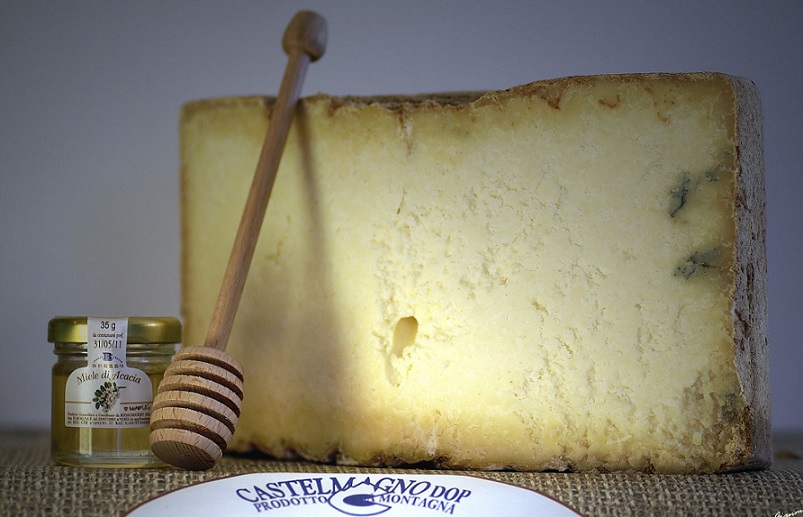If you have a soft spot for cheese, explore the wide variety of cheeses from Piedmont. In this North west Italy region, bordering with France and rich in alpine valleys, plenty of delicious cheeses are created from different types of milk. Cheese from cows, sheep and goat’s milk for all cheese lovers, even the most demanding palates.
Let’s go through some of the highly appreciated cheeses from Piedmont:
Murazzano
A cheese made from sheep’s milk mixed with a small percentage of cow’s milk available only from May to October. It takes its name from the quaint village of Murazzano, one of some 50 villages in the Cuneo province, where it is made.
It has a soft white paste with a delicate flavour. After maturation (ca. 10 days) it becomes slightly spicy and the thin crust tends to turn yellow. Murazzano comes in small cylindrical forms with flat faces.
Raschera
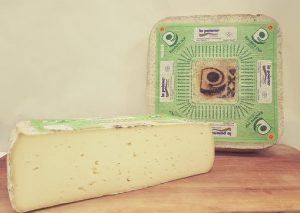
Photo: Coop. Agr. LA POIANA – VALLE GRANA
This Piedmont delicacy is traditionally made in the province of Cuneo. It is a semi-hard fat cheese produced using a mix of skimmed cow, goat, and sheep’s milk. It is square-shaped for a very practical reason. In the old days, dairymen used to stack the cheeses on top of each other and transport them with mules from the Alps down to the valleys.
Castelmagno
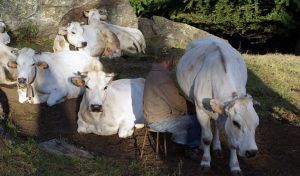
Photo: Produttori Alta Valle Grana Soc.Agr.Coop
It is definitely one of the most representative cheeses from Piedmont. Castelmagno is a semi-hard cylindrical-shaped cheese, made from cow’s milk with a small addition of sheep and/or goat’s milk. It is used to prepare typical dishes such as a creamy sauce for the “Gnocchi al castelmagno”. It has been produced since the early 1200s in three alpine villages in the Cuneo Province: Castelmagno, Pradleves and Monterosso Grana located in the Grana Valley.
The cow’s milk used for the castelmagno is produced by two local cow breeds LA BRUNA and RAZZA PIEMONTESE. It is aged between 2 to 5 months, to get its strong, sharp flavor and grainy and crumbly texture.
Plaisentif
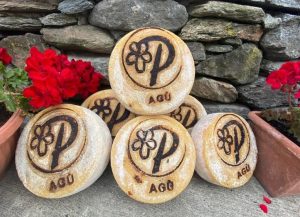
Cheesemonger: Agu’ Chiaffredo-Villar Perosa
Known also as the “cheese of violets”, Plaisentif has been produced in the Chisone and Susa Valleys (province of Turin) since about 1570. The name does not sound very Italian, because in these valleys bordering France people speak a local dialect similar to French.
The production of Plaisentif takes place in summer when the herds stay on high pastures, using raw cow’s milk. Between June and July, just after the snow has melted, violets blossom on the slopes. Afterwards the cattle feed on clover and other wildflowers. That’s why this cheese has a fruity, distinctive aromatic taste.
After maturing in stone cellars (min. 60 days), the ‘P’ logo and a beautiful flower are fire-branded on the upper face of the wheel. It is available on the market from September to March.
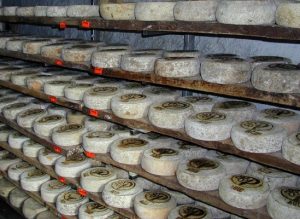
Photo: Agù Chiaffredo – Villar Perosa
You could possibly find some of these cheeses from Piedmont in your country, in deli shops specializing in Italian products or in a Eataly store, if you have one in your proximity.
However, some special artisan cheeses can be enjoyed only locally. For instance, there is a cheese with a strange name since it is piedmontese dialect: Tuma del lait brusch, which translates acid milk. The name might not sound very appealing, but it is exquisite.
I hope this article was mouth-watering and made you want to discover more. Feel free to contact us for a private, bespoke food tour to sample delightful cheeses from Piedmont and to experience the epicurean atmosphere of Turin.
Photo Castelmagno (above): Produttori Alta Valle Grana Soc.Agr.Coop
